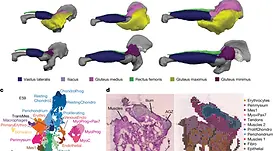
Vertebrate Paleontologist & Morphologist
University of Florida, Postdoctoral Researcher
Research
Click on the image (if active) to learn more about the project. Link icons go to the corresponding published paper, skull icons goes to the corresponding CT scan/3D model repository on MorphoSource.org.

Bird sternum morphology

Bird bone tissue distribution
Research interests:
Powered flight, a pivotal adaptation in vertebrate evolution, evolved independently three times. Pterosaurs evolved powered flight first in the late Triassic (~220 million years ago) and achieved the largest body size of any powered fliers. Powered flight evolved in birds by the Late Jurassic (~160 million years ago) and in bats by the Eocene (~52 million years ago). Few quantitative comparisons among these three clades exist for key structural attributes or functional parameters. Surveys of vertebrate flight tend to present analyses of the three clades into separate sections, and only comparing basic traits like aspect ratio, body mass, and wing loading. When they do discuss vertebrate fliers as a whole, the discussion turns to a theoretical volant animal instead of drawing comparisons between clades. Complicating such comparisons is their divergent wing structure.
My PhD research focused on the wing skeleton—its overall shape including integumental structures and the shape of the bony anchor (sternum) for the main muscles that power the wing. I aim to bring to light additional fundamental properties of vertebrate wings based in biological data, particularly those relating to possible constraints on bat maximum body size.
My current postdoc research involves CT scanning dead birds to visualize in 3D the anatomy of their lungs and compare the different lung shapes across avian taxa and track which part of the lung (pneumatic diverticula) goes inside which bone. I am also working on a couple side projects involving pterosaurs, because they likely share similar lung characteristics, and confusion about pterosaur pneumaticity is what got me into bird lungs in the first place.
I have also collaborated on a wide range of projects, from tadpole evolutionary development to Spinosaurus and other dinosaurs to oVert, a massive nationwide CT scanning endeavor.








